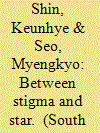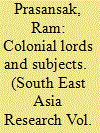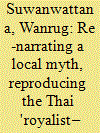|
|
|
Sort Order |
|
|
|
Items / Page
|
|
|
|
|
|
|
| Srl | Item |
| 1 |
ID:
142851


|
|
|
|
|
| Summary/Abstract |
In a hierarchical society, literature provides a window on the way in which culture governs the social – and sometimes political – construction of women's fidelity. This article explores how fidelity is socially embodied, regenerated and even imagined in literature by analysing two literary epics, Khun Chang Khun Phaen from Thailand and Chun Hyang Jeon from Korea. In analysing the two works side by side, the study examines the interplay between women and ruling ideologies. Focusing in particular on the heroines of the works, the authors assess why Wanthong, the heroine of Khun Chang Khun Phaen, is stigmatized as unfaithful in Thailand, whereas Chunhyang, the heroine of Chun Hyang Jeon, is a star and role model for righteous women in Korea.
|
|
|
|
|
|
|
|
|
|
|
|
|
|
|
|
| 2 |
ID:
142847


|
|
|
|
|
| Summary/Abstract |
This paper exposes colonial remnants in modern-day Thailand through a postcolonial materialist analysis of Lao Khamhom's 'Dust Underfoot'. Revolving around the conflict between a minor member of the Bangkok royalty and a Khmu forest worker in northern Thailand, this short story sheds light on Siam's semicolonial conditions created at the turn of the nineteenth century. Though nominally independent, Siam was subject to the capitalist world economy. This was clearly discernible in the British-dominated teak industry in the North. Siam, however, was not so much a victim as a collaborator and beneficiary of colonial capitalism. The Siamese monarchy sustained British capital by recruiting Khmu ethnic subjects into an exploitable labour force for timber production. This collaboration with the British enabled the monarchy to consolidate its economic, political and cultural power over its population. 'Dust Underfoot' underscores Siam's colonial legacies by critiquing the continued exploitation of the Khmu and other lumbermen by the emerging Thai sakdina-turned-bourgeois class in the 1950s. Following in the footsteps of the West, these royal elites viewed themselves as civilized rulers lording it over their 'savage' subjects. This paper also discusses the story as a seditious challenge to the hegemonic Buddhist 'god–king' discourse and translational process that underpins the foundation of the rule of the Thai monarchy.
|
|
|
|
|
|
|
|
|
|
|
|
|
|
|
|
| 3 |
ID:
142852


|
|
|
|
|
| Summary/Abstract |
This article examines representations of Thai society in fiction during the 1920s and 1930s. Initially the hobby of palace writers and readers, by the 1930s the evolving form had come to be widely popular with middle-class commoners. The rise of middle-class society was of profound importance in the interwar period: far beyond constituting a new reading and writing public, social and economic change undermined the political power of the old elite, and in 1932 a bureaucratic coup toppled the absolute monarchy. But the 'revolution', as it came to be known, was incomplete; the growth of new social classes and democratic ideas did not produce a new society. Nor, as this article demonstrates, did it destroy the cultural power of the old elite. The royal–aristocratic class remained cultural icons, and this is clearly shown in the new genre of realistic fiction that appeared. Royalist culture, an enduring aspect of twentieth century Thai history, maintained its power through a period of crisis largely because of its adaptation to changed circumstances.
|
|
|
|
|
|
|
|
|
|
|
|
|
|
|
|
| 4 |
ID:
142850


|
|
|
|
|
| Summary/Abstract |
For the past three decades, nationalism has been a topic of great interest among scholars in the field of Thai Studies. Most of these scholars have, however, neglected the issue of gender in their examination of Thai nationalism. This article addresses this oversight by examining Thawiphop (Two Worlds) and Khu kam (Sunset on the Chao Phraya), two of the most popular novels by Thommayanti. As a well known nationalist and self-proclaimed feminist, Thommayanti has united the topics of gender and nationalism in these two works by representing female protagonists who strive to play an active role in the nationalist effort. Close examination reveals, however, that the nationalism of both protagonists is based on the psychoanalytic structure of the family romance that ultimately leads to a subversion of their agency. Thus, despite Thommayanti's attempt to depict strong and independent women in her novels, her characters ultimately fall short of transcending their subordinate roles in the discourse of nationalism.
|
|
|
|
|
|
|
|
|
|
|
|
|
|
|
|
| 5 |
ID:
142849


|
|
|
|
|
| Summary/Abstract |
This article investigates cross-cultural encounters from the point of view of a local man who tries to gain the upper hand in power negotiations in the context of tourism. Through titillating narratives, he constructs 'white women' as 'loose', a stereotype which remains prevalent in Thai male perceptions of Western women in the twenty-first century. The article looks at selected semi-fiction from the 1972 collection Kai-phi Bangkok chut 1 (Bangkok Unlicensed Guide Collection 1) by Ta Tha-it in its capacity as a representative of the 'lowbrow' genre of 'male writing for male reading'. Exploring the narratives of sexual encounters between a local tour guide and Western women, it examines the sexualization of the farang (Western) body as a strategy for 'fun, games and gains' in cross-cultural sexual encounters. In the three stories discussed, the sexualized farang bodies turn out to be homosexual, masochistic and aged respectively, while the Thai body is hetero-normative, young and virile. The entire collection from which this analysis is drawn was composed in the 1970s against the backdrop of Cold War Thailand as an emerging tourist destination for US soldiers in Indochina and of the rise of international tourism in Thailand.
|
|
|
|
|
|
|
|
|
|
|
|
|
|
|
|
| 6 |
ID:
142848


|
|
|
|
|
| Summary/Abstract |
This analysis of 'The Myth of Sao Hai', a short story by the contemporary Thai author Daen-arun Saengthong, focuses on the transformative act of translating an oral provincial myth into written literary form. 'The Myth of Sao Hai' depicts the sacrifice for the 'nation' of a female spirit inhabiting a millennial tree in a remote part of the jungle. The contention in this paper is that the myth, as re-narrated by Daen-arun, reveals the problematic conditions under which peripheral voices are constantly relegated to a subaltern position in relation to the centre. These are the same conditions under which Thailand's local history has been written: that is to say, under and through a hegemonic 'royalist–nationalist' history. However, through an analysis of 'ironic fissure' – that is, of dissident voices which disrupt the narrative homogeneity – the paper argues that the relationship between the national and the local is not mirrored in a fixed binary opposition of oppression and subordination. Rather, the relationship is marked by ambivalence, an ambivalence that is crucial to the possibility of the writing and the 'narration' of both.
|
|
|
|
|
|
|
|
|
|
|
|
|
|
|
|
| 7 |
ID:
142846


|
|
|
|
|
| Summary/Abstract |
This article re-examines the significance of Senee Saowaphong’s canonical Thai novel Peesart (The Spectre) in two key ways: by locating this work in the context of the rapid economic and social changes that took place in Thailand after the Second World War, and by identifying the modernist impulse as an underlying novelistic structure that forms and informs the clashes between the aristocrats and the commoners and between the urban and the rural. Employing Bhabha’s concept of hybridity and Anderson’s double provincialism, the article rereads the novel’s protagonist, Sai Seema, an iconic hero of the 1970s Thai student movement, as a hybrid figure. It is the ambivalence and undecidability of this character that destabilizes and subverts the power and authority of Bangkok elites in the text.
|
|
|
|
|
|
|
|
|
|
|
|
|
|
|
|
|
|
|
|
|